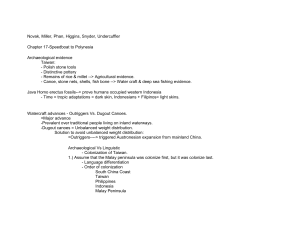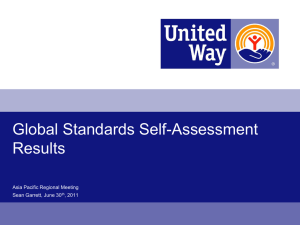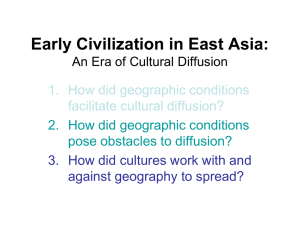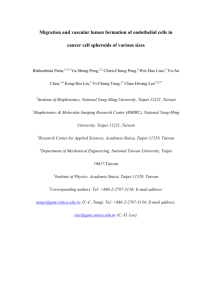Blundell-Asia-Pacific-Cultural-History-and-Society-QP-T02-07
advertisement
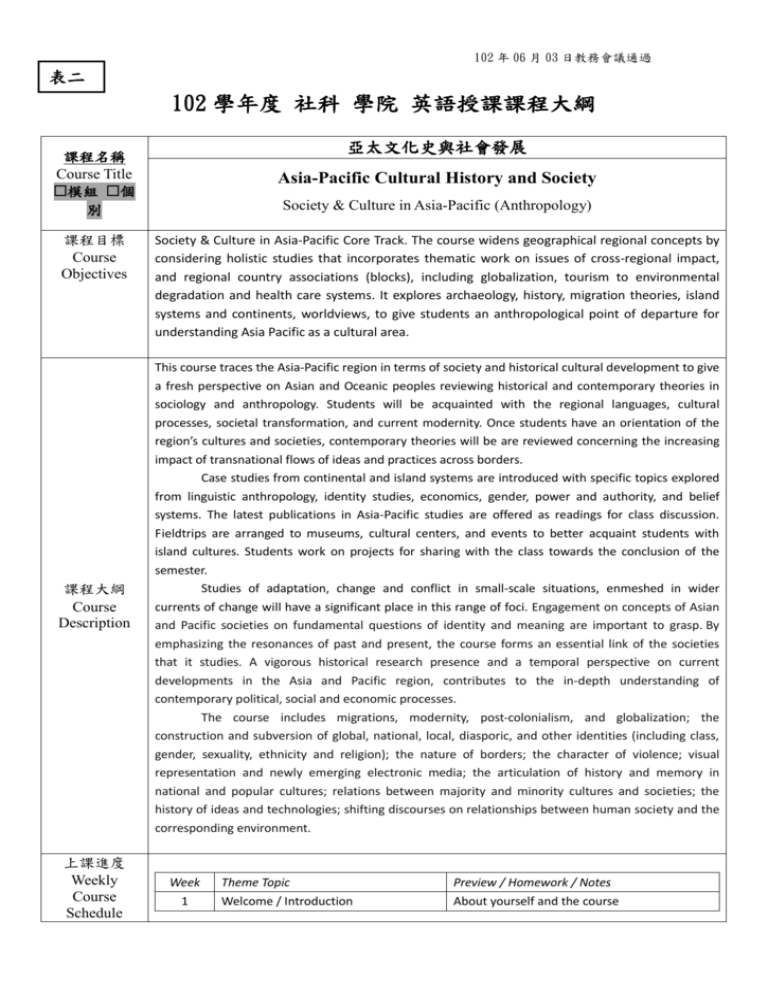
102 年 06 月 03 日教務會議通過 表二 102 學年度 社科 學院 英語授課課程大綱 亞太文化史與社會發展 課程名稱 Course Title 模組 個 別 課程目標 Course Objectives 課程大綱 Course Description 上課進度 Weekly Course Schedule Asia-Pacific Cultural History and Society Society & Culture in Asia-Pacific (Anthropology) Society & Culture in Asia-Pacific Core Track. The course widens geographical regional concepts by considering holistic studies that incorporates thematic work on issues of cross-regional impact, and regional country associations (blocks), including globalization, tourism to environmental degradation and health care systems. It explores archaeology, history, migration theories, island systems and continents, worldviews, to give students an anthropological point of departure for understanding Asia Pacific as a cultural area. This course traces the Asia-Pacific region in terms of society and historical cultural development to give a fresh perspective on Asian and Oceanic peoples reviewing historical and contemporary theories in sociology and anthropology. Students will be acquainted with the regional languages, cultural processes, societal transformation, and current modernity. Once students have an orientation of the region’s cultures and societies, contemporary theories will be are reviewed concerning the increasing impact of transnational flows of ideas and practices across borders. Case studies from continental and island systems are introduced with specific topics explored from linguistic anthropology, identity studies, economics, gender, power and authority, and belief systems. The latest publications in Asia-Pacific studies are offered as readings for class discussion. Fieldtrips are arranged to museums, cultural centers, and events to better acquaint students with island cultures. Students work on projects for sharing with the class towards the conclusion of the semester. Studies of adaptation, change and conflict in small-scale situations, enmeshed in wider currents of change will have a significant place in this range of foci. Engagement on concepts of Asian and Pacific societies on fundamental questions of identity and meaning are important to grasp. By emphasizing the resonances of past and present, the course forms an essential link of the societies that it studies. A vigorous historical research presence and a temporal perspective on current developments in the Asia and Pacific region, contributes to the in-depth understanding of contemporary political, social and economic processes. The course includes migrations, modernity, post-colonialism, and globalization; the construction and subversion of global, national, local, diasporic, and other identities (including class, gender, sexuality, ethnicity and religion); the nature of borders; the character of violence; visual representation and newly emerging electronic media; the articulation of history and memory in national and popular cultures; relations between majority and minority cultures and societies; the history of ideas and technologies; shifting discourses on relationships between human society and the corresponding environment. Week 1 Theme Topic Preview / Homework / Notes Welcome / Introduction About yourself and the course 102 年 06 月 03 日教務會議通過 教學方式 Instructional Methods 課程要求 Course Requirements 評量方式 Evaluation 2 What is the Asia Pacific? Geography 3 Surveying the region, blocks Discussion, blocks, e.g. ASEAN 4 Continents and Islands Where do people live? 5 Migrations and navigations Film: The Navigators 6 Peoples, languages, beliefs Bring an article to share 7 Archaeology – latest discoveries Guest speaker – Chen Chung-yu 8 Taiwan’s place in Asia Pacific Theories and origins 9 Regional case studies Issues, e.g. India 10 Midterm exam Held in class 11 Asia Pacific in the news Students report on latest news 12 Conflict and politics Crisis and social reconstruction 13 What the region means to you? Discussion 14 Topic to be selected Student interaction 15 Review of the region Prepare group presentations 16 Group Presentations Selected topics 17 Group Presentations Finalize the term paper 18 Final paper due Seminar conclusion Our studies are marked by close attention to written, documentary, oral, and visual sources. It combines particular empirical interests with reflection on the nature of social science inquiry, representation, and writings in related disciplines. The methods include the reading of texts for meaning and the rigorous practice of study and criticism. Requirements and course activities include keeping a weekly notebook, participating in outings, taking a quiz, and writing a term paper. Grading is based on (1) attendance and participation 20%, (2) mid-term 20%, (3) notebook/journal records 10%, (4) group presentation 20%, (5) final 30%. The final is a research paper based on a topic suggested in advance. Length is about (10-12) double-spaced carefully written pages with critical and informed opinion. Selected Readings Adams, K. M. 1984. Come to Tana Toraja, ‘land of the heavenly kings’: Travel agents as brokers of ethnicity. Annals of Tourism Research 11: 469-485. Aikman, D. 1986. Pacific Rim: Area of Change, Area of Opportunity. Boston, Toronto: Little, Brown and Company. 教材及參考書 目 Anderson, C. A. 2009. The new Austronesian voyaging: Cultivating Amis folk songs for the international Textbooks & stage. Austronesian Taiwan, ed. Blundell, D., revised edition, 282–318. Taipei: Shung Ye Museum, Suggested Berkeley: Phoebe A. Hearst Museum of Anthropology. Materials Appadurai, A. 1981. The past as a scarce resource. Man 16(2): 201–219. Barnes, R. H., Gray, A. and Kingsbury, B. 1995. Indigenous peoples of Asia, 48. Ann Arbor, MI: Association for Asian Studies, Monograph and Occasional Paper Series. Bellwood, P. 2009. Formosan prehistory and Austronesian dispersal. Austronesian Taiwan: Linguistics, 102 年 06 月 03 日教務會議通過 History, Ethnology, Prehistory, ed. Blundell, D., revised edition, 336–364. Taipei: Shung Ye Museum, Berkeley: Phoebe A. Hearst Museum, University of California. Blust, R. 1996. Austronesian culture history: The window of Language. Prehistoric Settlement of the Pacific, ed. Goodenough, W. H. Philadelphia: American Philosophical Society. Blundell, D. 2004. Taiwan and the Pacific, lingua franca, multilingualism education and endangered languages. First Conference on Language Development, Language Revitalization, and Multilingual Education in Minority Communities in Asia. Publication of the Summer Institute of Linguistics (SIL), UNESCO & Mahidol University, Bangkok, Thailand, November 7th–9th (http://www.sil.org/asia/ldc/parallel_papers/david_blundell.pdf). _____. 2009. Languages connecting the world. Austronesian Taiwan: Linguistics, History, Ethnology, Prehistory, ed. Blundell, D., revised edition, 401–458. Taipei: Shung Ye Museum, Berkeley, CA: Phoebe A. Hearst Museum. _____. 2011. Developing a Concept of Austronesia. Working Session: Austronesian Linkages. Association for Social Anthropology in Oceania Annual Meeting. Honolulu, HI, February 9th-12th. _____. 2011. Mapping endangered languages of the Pacific: Case studies in Taiwan, Orchid Island, and the Batanes. Issues of Language Endangerment. Xu Shixuan, Tjeerd de Graaf, and Cecilia Brassett, eds. Beijing: Anthropology and Ethnology Today Book Series of the 16th World Congress of IUAES. Pp. 3-20. _____. 2011. Taiwan Austronesian language heritage connecting Pacific island peoples: Diplomacy and values. International Journal of Asia-Pacific Studies (IJAS), 7(1): 75-91. Website: http://ijaps.usm.my/?page_id=102 Article: http://ijaps.usm.my/?page_id=493 _____. 2012. Taiwan coming of age. Taiwan Since Martial Law: Society, Culture, Politics, Economics. David Blundell, ed. Berkeley: University of California & National Taiwan University Press. Pp. 2-24. _____. 2013. Dr B R Ambedkar and Buddhism in the perspective of the cultural unity of India. Cultural Unity of India. Sabysachi Bhattacharya, ed. Ramakrishna Mission Institute of Culture. Pp. 355-372. _____. In Press. Vedda (Vanniyaletto) as folk life intangible cultural heritage in Sri Lanka. Bulletin of the Indo-Pacific Prehistory Association. Blundell, D. and J. Zerneke. In Press. Early Austronesian historical voyaging in Monsoon Asia: Heritage and knowledge for museum displays utilizing texts, archaeology, digital interactive components, and GIS approaches. International Journal of Humanities and Arts Computing. Buckland, M. K. 2004. Histories, heritages, and the past: The case of Emanuel Goldberg. The History and Heritage of Scientific and Technical Information Systems, ed. Rayward, W. B. and Bowden, M. E., 39–45. Medford, NJ: Information Today. Goody, J. 1996. The East in the West. New York: Cambridge University Press. Hansen, V. 1993. Gods on Walls: A Case of Indian Influence on Chinese Lay Religion? In Religion and Society in T’ang and Sung China, ed. P. B. Ebrey and P. N. Gregory, University of Hawaii Press. Chang, K. 1989. Taiwan Archaeology in Pacific Perspective. Anthropological Studies of the Taiwan Area: Accomplishments and Prospects, ed. Li, K., Chang, K., Wolf, A. P. and Yin, A. C., 87–97. Taipei: Department of Anthropology, National Taiwan University. Chen, J. C. and Chang, M. 1996. A Bibliography for Archaeology and Related Studies of the South China Sea Area. Taipei: Program for Southeast Asian Area Studies (PROSEA) and Institute of History and Philology, Academia Sinica. 102 年 06 月 03 日教務會議通過 Chen, C., Chuang, Y. and Huang, S., eds. 1994. Ethnicity in Taiwan: Social, Historical, and Cultural Perspectives. Taipei: Institute of Ethnology, Academia Sinica. Crocombe, R. 1999. Basis for belonging to Polynesia. The Politics of Anthropology at Home 8(1): 31-60. Davis, W. 1992. Japanese Religion and Society: Paradigms of Structure and Change. New York: State University of New York Press. Diamond, J. M. 2000. Taiwan’s gift to the world. Nature 403: 709–710. Fentress, J. and Wickham, C. 1992. Social Memory. Oxford: Blackwell. Fox, J. J. and Sather, C., eds. 1996. Origins, Ancestry and Alliance: Exploration in Austronesian Ethnography. Canberra: Australian National University, Department of Anthropology of the Research School of Pacific and Asian Studies, Comparative Austronesian Project Publication. Jazeel, T. 2009. Reading the geography of Sri Lankan island-ness: Colonial repetitions, postcolonial possibilities. Contemporary South Asia 17(4): 399-414. Keyes, C. F. 1979. Ethnic Adaptation and Identity. Philadelphia: ISHI. Kirch, P. V. 2000. On the Road of the Winds: An Archaeological History of the Pacific Islands Before European Contact. Berkeley: University of California Press. Oppenheimer, S. and Richards, M. 2001. Fast trains, slow boats, and the ancestry of the Polynesian islanders. Science 84(3): 157-181. Richards, M. 2008. New research forces u-turn in population migration theory. University of Leeds, 23 May. http://www.leeds.ac.uk/news/article/ 350/new_research_forces_u-turn_in_population_migration_theory Remo, A. R. 2013. Out to forge ties, ASEAN flexes muscle as a bloc. Philippine Daily Inquirer. November 1st. http://business.inquirer.net/150457/out-to-forge-ties-asean-flexes-muscle-as-a-bloc Steward, J. 1955. Theory of Culture Change: The Methodology of Multilinear Evolution. Chicago: University of Illinois Press. Tsai, P. 1999. Towards a greater Austronesian cultural sphere. European Society of Oceanists, Leiden, June 26th. Valeri, V. 1985. Kingship and Sacrifice: Ritual and Society in Ancient Hawaii. Chicago: University of Chicago Press. Wurm, S. A., ed. 1997. Materials on languages in danger of disappearing in the Asia-Pacific region. No. 1. Some Endangered Languages of Papua New Guinea: Kaki Ae, Musom, and Aribwatsa. Pacific Linguistics, Series D-89. Canberra: Research School of Pacific and Asian Studies, The Australian National University. Wurm, S. A. and Hattori, S., eds. 1981 [Part 1] and 1983 [Part 2]. Language Atlas of the Pacific Area. The Australian Academy of the Humanities in Collaboration with the Japan Academy. Canberra: The Australian National University. 102 年 06 月 03 日教務會議通過 課程相關 連結網址 Course Website 備註 Remarks 申請教師簽章: To be developed. Spring 2014, Tuesday 6:30-9:30 pm 開課單位主管簽章:

